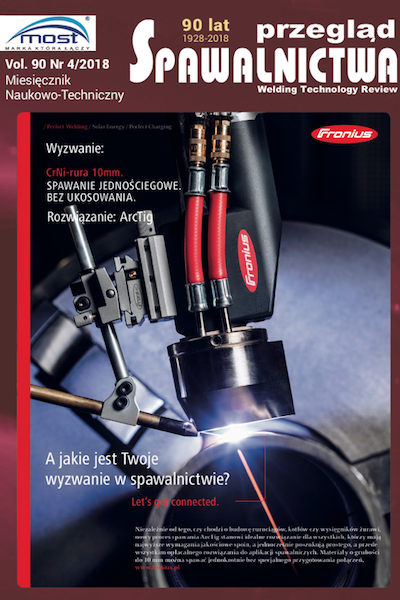Corrosion resistance of a NiCrFeSi coating heat-loaded in atmosphere of air and in sulfur environment
Main Article Content
Abstract
The paper deals with a NiCrFeSi coating plasma- sprayed on a boiler steel (P 250GH) substrate. The coating was heat-loaded in atmosphere of air and in sulfur environment. The heat load comprised 2000 cycles, whereas each of the cycles included: heating up to 560 °C and soaking at the temperature for 3 minutes; cooling down to 300 °C and soaking at the temperature for 1.5 minutes; and cooling down to 150 °C. As a result of such thermal cycling, thickness of the coating was reduced by 39 μm. It has been found that sulfur had diffused into the superficial layer. The occurring products of sulfur reacting with chromium and nickel contributed to spalling of components of the layer which subsequently were subject to oxidation.
in Polish
Odporność na korozję powłoki NiCrFeSi obciążonej cieplnie w atmosferze powietrza i w środowisku siarki
Praca dotyczy natryskiwanej plazmowo powłoki NiCrFeSi na podłoże ze stali kotłowej (P 250GH). Powłokę obciążano cieplnie w atmosferze powietrza i w środowisku siarki. Obciążenie cieplne wynosiło 2000 cykli. Jeden cykl obejmował: nagrzewanie do temperatury 560 °C i wygrzewanie w tej temperaturze w czasie 3 minut, chłodzenie do temperatury 300 °C, nagrzewanie do 560 °C i wygrzewanie w tej temperaturze w czasie 1,5 minuty oraz chłodzenie do temperatury 150 °C. Efektem obciążeń cieplnych było zmniejszenie grubości powłoki o 39 μm. Stwierdzono, że siarka dyfundowała w warstwę przypowierzchniową. Tworzące się produkty jej reakcji z niklem i chromem sprzyjały wykruszaniu się składników tej warstwy, które następnie ulegały utlenianiu.
Downloads
Article Details
Creative Commons CC BY 4.0 https://creativecommons.org/licenses/by/4.0/
Welding Technology Review (WTR) articles are published open access under a CC BY licence (Creative Commons Attribution 4.0 International licence). The CC BY licence is the most open licence available and considered the industry 'gold standard' for open access; it is also preferred by many funders. This licence allows readers to copy and redistribute the material in any medium or format, and to alter, transform, or build upon the material, including for commercial use, providing the original author is credited.
References
Radziszewski A., Radziszewski A.: Defects in thermal sprayed coatings occurred during manufacturing and operation, Przegląd Spawalnictwa, nr 9, pp. 42-45, 2012.
Uusitalo M.A., Vuoristo P.M.J., Mäntylä T.A.: Elevated temperature erosion-corrosion of thermal sprayed coatings in chlorine containing environ- ments, Wear, vol. 252, pp. 586-594, 2002.
Szymański K., Hernas A., Moskal G., Myalska H.: Thermally sprayed coatings resistant to erosion and corrosion for power plant boilers A review, Surface & Coatings Technology, vol. 268, pp. 153-164, 2015.
Miguel J.M., Guilemany J.M., Vizcaino S.: Tribological study of NiCrBSi coating obtained by different process, Tribology International, vol. 36, pp. 181-187, 2003.
Hurricks P.L.: Some aspects of the metallurgy and wear resistance of surface coatings, Wear, vol. 2, pp. 291-320, 1972.
Wang H., Xia W., Jin Y.: A study on abrasive resistance of Ni-based coatings with a WC hard phase, Wear, vol. 195, pp. 47-52, 1996.
Kulu P., Pihl T.: Selection criteria for wear resistance powder coatings under extreme erosive wear conditions, Journal Thermal Spray Technology, vol. 11, pp. 517-522, 2002.
